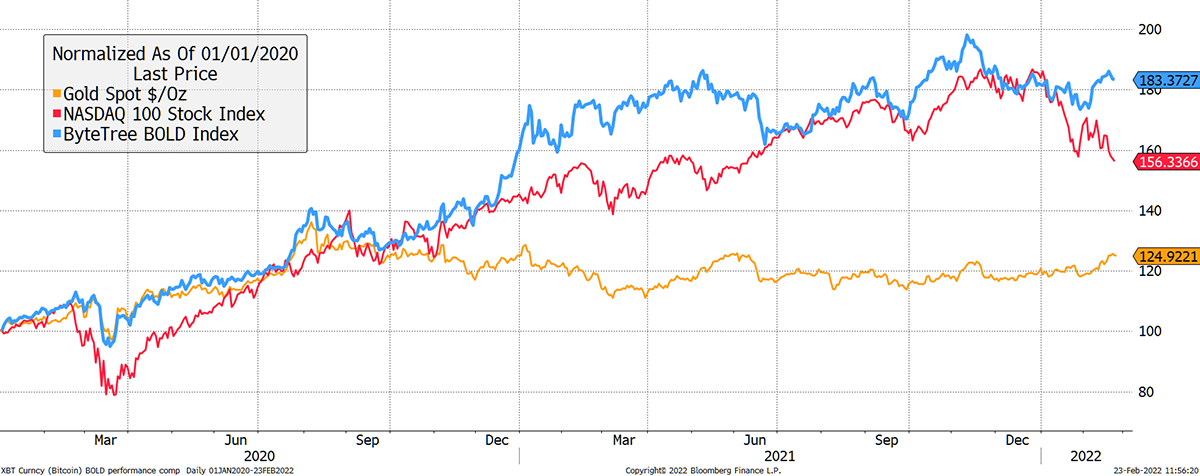The ByteTree BOLD Index: An Alternative Asset for Institutional Investors

Disclaimer: Your capital is at risk. This is not investment advice.
ByteTree BOLD
2022 got off to a rough start, and the ByteTree BOLD Index has held up well. Gold has risen, just as it normally does when geopolitics heats up. With an 82.6% allocation to gold, BOLD has managed to offset the weakness in bitcoin.
Remarkably, the fall in bitcoin is modest because while risk-off conditions will always be a challenge for growth assets, current events remind us why society needs to embrace a digital world. This is inevitable.
Governments are keen to embrace central bank digital currencies, not just in China, but seemingly everywhere. Some for good, and others for bad, yet both Russia and Ukraine are contemplating an increasing role for bitcoin in the official payments sector for completely different reasons. Russia wants to work around sanctions, whereas Ukraine wants to liberate its citizens.
These should not be disregarded as isolated cases because the world is becoming a more complex place. Even in Canada, where the truck drivers are expressing their legitimate right to protest, they are being denied access to the banking system. This demonstrates that law-abiding people should protect themselves from involuntary state sanctions.
Despite these positive undercurrents, the price of bitcoin is down this year, along with most risky assets. That is to be expected during risk-off market conditions. Bitcoin also faces pressure from a weak point in the four-year halving cycle where it is approaching the halfway mark. Historically, this has been its most challenging period, yet the price has remained remarkably resilient.
So far in 2022, bitcoin has seen substantially lower losses than witnessed in speculative loss-making tech stocks. These losses are not dissimilar to the tech sector in general, and if this is the new normal, then bitcoin just got promoted in the asset quality league tables. Things really are looking up.
Gold the forecaster
From 2018 to 2020, gold performed well because it saw what was coming. It didn’t forecast a pandemic, or any other events in the real world, but it saw a need for easier monetary policy and a new round of fiscal and monetary stimulus. Once Covid-19 appeared on the WHO’s radar, the money printers got to work.
This all happened during the first lockdown. I remember sitting on various asset allocation committees where the conversation was all about the virus. The stock market was surging, and bitcoin along with it, just as gold was running out of steam. As it is more often than not, the consensus view was way behind the curve. Just as fears were building, gold was already stalling from a rally that attracted $50 billion into the ETFs. As this was happening, risky assets were already starting to surge.
This behavioural composition is what makes BOLD so resilient in both good times and bad. Gold is established and a beneficiary of bad news at times of stress, while bitcoin sits at the heart of exchanging value between machines. Just as there will be more bad times in the future, there will also be good times. I am certain that machines will exchange substantially more value ten years from now than they do today.
BOLD and tech have much in common

Since the beginning of 2020, BOLD has shown remarkable qualities that make it a highly credible alternative asset and portfolio diversifier.
In the March Covid crash, BOLD resembled gold more than bitcoin or tech, which both faced substantial losses. Yet during the height of the boom in late 2020, just a modest allocation to bitcoin was enough to exceed the returns delivered by tech. Then most recently, in an era of fear and falling asset prices, BOLD has once again shown resilience.
Sometimes the best ideas are simple. BOLD is just that, as it combines bitcoin and gold according to their assumed risk. We know to a high degree of certainty that bitcoin will do well in the good times, and gold during the bad. Optimising the combination is therefore key. The use of 360-day realised volatility has consistently demonstrated good results over multiple time frames.
BOLD has been designed using sound investment principles to protect investors from inflation during good times and bad. Following a decade for asset returns which was too good to be true, the next decade is almost certain to disappoint. Investors need to think differently, and BOLD was purpose-built for the task.

Comments ()